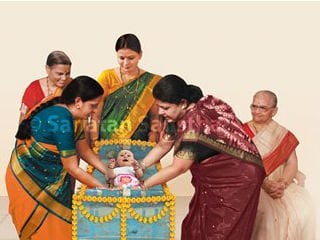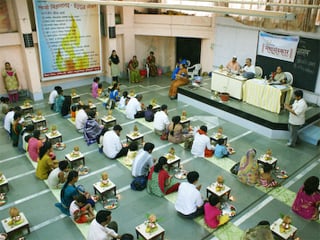Objectives
The word ‘Simantonnayan’ is obtained from two words – simant (meaning, the line of parting of hair) andunnayan (meaning, combing hair from the sides to the top). Simantonnayan thus means, parting the wife’s hair, drawing the hair from the sides upwards. As a result, pleasant waves enter her body through the Sahasrar-chakra and facilitate proper growth of the foetus.
The auspicious time
Lunar asterism with the masculine gender is necessary for Simantonnayan. If this sanskar is performed in a month with an even number, preferably in the fourth month, then it is most beneficial. This ritual is for the purification of the foetus. It is equally important that he/she be born without deformities, have good health and intelligence. For the overall development of all organs of the foetus, performing Simantonnayan during pregnancy is important.’
The ritual
The husband should part his wife’s hair with a bunch of fruit of the audumbar tree, spikes of the porcupine (which procreates in large numbers) and three blades of plaited darbha. In some regions, there is a custom of garlanding the woman with a string of wheat crop and fruits of audumbar. ‘Due to the offering of Prasad (Holy sacrament) from the fire sacrifice, charged with mantras from Simantonnayan, and the sanskar of Simantonnayan performed with bhav (Spiritual emotion) on the pregnant woman using the audumbar branch bearing many fruits and the porcupine spike, the Chaitanya in her gets activated, giving maximum benefit to the foetus.’

 Garbhadhan (Rutushanti) – First Sanskar
Garbhadhan (Rutushanti) – First Sanskar Namakaran (Naming ceremony)
Namakaran (Naming ceremony) Sanskars performed after the birth of a child ! (Fourth, Fifth, Sixth and Seventh Sanskar)
Sanskars performed after the birth of a child ! (Fourth, Fifth, Sixth and Seventh Sanskar) Choulkarma (Chudakarma) – keeping a shendi !
Choulkarma (Chudakarma) – keeping a shendi ! Upanayan (Vratabandha, Munja) – Ninth Sanskar
Upanayan (Vratabandha, Munja) – Ninth Sanskar Medhajanan (Palsola vidhi)
Medhajanan (Palsola vidhi)